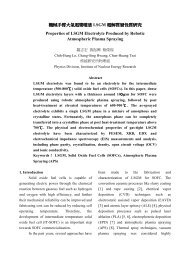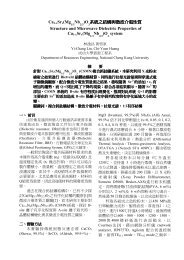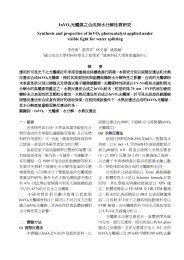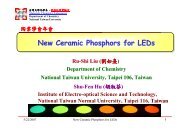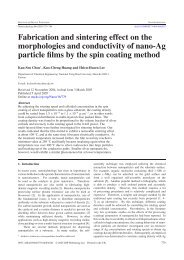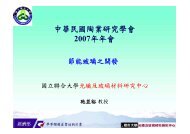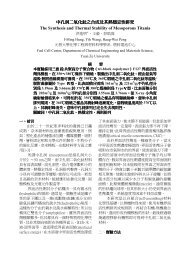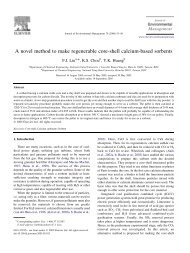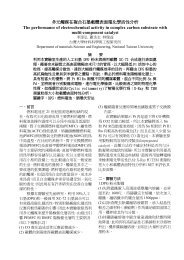IrO 2
IrO 2
IrO 2
You also want an ePaper? Increase the reach of your titles
YUMPU automatically turns print PDFs into web optimized ePapers that Google loves.
Conductive <strong>IrO</strong> 2 Nanocrystals<br />
Department of Electronic Engineering,<br />
National Taiwan University of Science and<br />
Technology<br />
黃鶯聲<br />
黃鶯聲<br />
Ying-Sheng Huang<br />
E-mail: ysh@mail.ntust.edu.tw
ACKNOWLEDGMENTS<br />
NSC93,94,95-2120-M011-001<br />
Fred H Pollak, Physics Dept., Brooklyn College of<br />
NYCU<br />
Yun Chi, Dept. of Chemistry, NTHU<br />
Dah-Shyang Tsai, Dept. of Chemical Eng., NTUST<br />
Reui-San Chen, Alexandru Korotcov, Dept. of<br />
Electronic Eng., NTUST<br />
….
Outline<br />
Introduction and background<br />
Growth and characterization of 1D nanosized<br />
<strong>IrO</strong> 2 crystals<br />
Size effect of 1D nanocrystals studied by<br />
Micro-Raman spectroscopy<br />
Field emission: <strong>IrO</strong> 2 nanorods<br />
Gas sensing and electrocatalysis applications<br />
Summary
<strong>IrO</strong> 2 and RuO 2 Single Crystals: The<br />
bigger the better, 1982<br />
<strong>IrO</strong> 2<br />
RuO 2
Nanosized <strong>IrO</strong> 2 and RuO 2 :<br />
The smaller the better, 2007<br />
<strong>IrO</strong> 2 nanotubes<br />
RuO 2 nanorods
Our previous work in single crystal growth<br />
shows the strong 1D growth behavior of <strong>IrO</strong> 2<br />
Sizes:<br />
2∼30 μm<br />
Length:<br />
0.1∼30 mm
Rod-like <strong>IrO</strong> 2 crystals reveal clear<br />
prismatic facets
Introduction<br />
<strong>IrO</strong> 2 belong to the family of conductive transition metal oxides<br />
with rutile-type structure.<br />
The material possesses an interesting variety of electrical<br />
properties<br />
Corrosion-resistant conductive electrode material<br />
Fundamental properties of the conductive oxides, including RuO 2, <strong>IrO</strong> 2 and OsO 2<br />
Crystal structure<br />
Lattice constant<br />
Bulk resistivity<br />
(μΩ-cm) at 300 K<br />
RuO2<br />
Tetragonal rutile<br />
a = 4.499Å<br />
c = 3.107 Å<br />
20-40<br />
<strong>IrO</strong>2<br />
Tetragonal rutile<br />
a = 4.498 Å<br />
c = 3.15 4Å<br />
32-50<br />
OsO2<br />
Tetragonal rutile<br />
a = 4.50 Å<br />
c = 3.18 Å<br />
60
Applications of conductive oxides<br />
<strong>IrO</strong> 2<br />
Optical switching layers in electrochromic<br />
devices<br />
PH-sensing materials<br />
Electrocatalysis for water oxidation<br />
Electrode materials in ferroelectric capacitors<br />
for nonvolatile memories<br />
Emitter materials of field emission cathode<br />
arrays used in vacuum microelectronic<br />
devices and field emission flat panel displays
Advantages of nanosized <strong>IrO</strong> 2<br />
Low Electrical Resistivity<br />
High Thermal and Chemical Stability<br />
Enhance the material properties by<br />
controlling the microstructure
Growth and characterization<br />
of <strong>IrO</strong> 2 nanocrystals<br />
Growth techniques:<br />
1. Cold-wall and vertical flow MOCVD<br />
2. RF reactive magnetron sputtering<br />
Characterization:<br />
Morphology→ FESEM<br />
Structure and orientation→ XRD, TEM, SAD<br />
Composition→ XPS, EDS<br />
Microstructure→ Micro-Raman<br />
Possible applications:<br />
Field emitters, Sensors, Electrocatalysis
Schematic diagram of MOCVD system<br />
Precursors:<br />
(MeCp)(COD)Ir<br />
Conditions<br />
Growth<br />
Temp.<br />
( o C)<br />
Growth<br />
Pressure<br />
(Torr)<br />
O2 flow rate<br />
(sccm)<br />
<strong>IrO</strong>2<br />
350<br />
10-50<br />
100
Schematic diagram of home-made HV RF<br />
magnetron sputtering system<br />
Target<br />
Substrate [Al 2O 3 - sapphire (SA)]<br />
RF power<br />
Background pressure<br />
Sputtering pressure<br />
Substrate temperature<br />
O 2 / Ar flows<br />
1- inch Ir (99.95%)<br />
(001); (100); (012); (110)<br />
65 W<br />
3×10 -5 mBar<br />
~ 6.5×10 -2 mBar<br />
300-400°C<br />
2.5 / 5.0 sccm
Our CVD apparatus
Morphology of <strong>IrO</strong> 2 nanotubes grown on<br />
rhombohedral LiTaO 3(012) substrate
Morphology of <strong>IrO</strong> 2 nanorods grown on<br />
rhombohedral LiTaO 3(012) substrate
Morphology of <strong>IrO</strong> 2 nanorods grown on<br />
rhombohedral LiTaO 3(012) substrate<br />
Size: 50-100 nm
XRD patterns show the growth of <strong>IrO</strong> 2 on LiTaO 3 (012)<br />
having single orientation of (101)<br />
Intensity<br />
2000<br />
1500<br />
1000<br />
500<br />
0<br />
LTO(012)<br />
<strong>IrO</strong> 2 (101)<br />
20 25 30 35 40 45 50 55 60 65<br />
2θ
Corss-sectional TEM image and SAD patterns<br />
indicate the epitaxially growth of<br />
<strong>IrO</strong> 2 nanotubes on LiTaO 3(012) substrate<br />
<strong>IrO</strong> 2[001]<br />
35 o<br />
<strong>IrO</strong> 2[101]
<strong>IrO</strong> 2 nanotubes on various oxide substrates (I)<br />
The growth with vertical alignment can be achieved using these oxide substrates<br />
On YSZ(110) On LiNbO3 (100) On Sapphire(100)
Single variant<br />
alignment<br />
Six variants<br />
alignment<br />
<strong>IrO</strong> 2 nanotubes on various oxide substrates (II)<br />
On LiTaO 3 (012) On Sapphire(110)<br />
On YSZ(111) On YSZ(100)<br />
Double<br />
variants<br />
alignment<br />
Remark: YSZ is<br />
yttrium stabilized ZrO 2<br />
Eight variants<br />
alignment
<strong>IrO</strong> 2 nanotubes on YSZ(110) substrate
<strong>IrO</strong> 2 nanotubes on YSZ(110) substrate
<strong>IrO</strong> 2 nanotubes on YSZ(110) substrate<br />
Intensity<br />
10000<br />
5000<br />
0<br />
<strong>IrO</strong> 2 (110)<br />
<strong>IrO</strong> 2 (101)<br />
YSZ(110)<br />
<strong>IrO</strong> 2 (211)<br />
<strong>IrO</strong> 2 (002)<br />
20 25 30 35 40 45 50 55 60 65<br />
2θ
<strong>IrO</strong> 2 nanotubes on LiNbO 3 (100) substrate
<strong>IrO</strong> 2 nanotubes on LiNbO 3 (100) substrate
<strong>IrO</strong> 2 nanotubes on LiNbO 3 (100) substrate<br />
Intensity<br />
12000<br />
10000<br />
8000<br />
6000<br />
4000<br />
2000<br />
0<br />
<strong>IrO</strong> 2 (002)<br />
LNO(300)<br />
20 25 30 35 40 45 50 55 60 65<br />
2θ
<strong>IrO</strong> 2 nanotubes on sapphire(100) substrate
<strong>IrO</strong> 2 nanotubes on sapphire(100) substrate
<strong>IrO</strong> 2 nanotubes on sapphire(100) substrate
The TEM images and SAD pattern reveal<br />
the 1D <strong>IrO</strong> 2 crystals with tubular morphology<br />
and have long axes toward [001] direction<br />
[001]
<strong>IrO</strong> 2 nanotubes on sapphire(100) substrate
<strong>IrO</strong> 2 nanotubes on sapphire(100) substrate<br />
Intensity<br />
35000<br />
30000<br />
25000<br />
20000<br />
15000<br />
10000<br />
5000<br />
0<br />
<strong>IrO</strong> 2 (002)<br />
20 25 30 35 40 45 50 55 60 65<br />
2θ
<strong>IrO</strong> 2 nanotubes on LiTaO 3 (012) substrate<br />
Single<br />
variant<br />
alignment<br />
Intensity<br />
2000<br />
1500<br />
1000<br />
500<br />
0<br />
LTO(012)<br />
<strong>IrO</strong> 2 (101)<br />
20 25 30 35 40 45 50 55 60 65<br />
2θ
<strong>IrO</strong> 2 nanotubes on sapphire(110) substrate<br />
Two variants<br />
alignment
<strong>IrO</strong> 2 nanotubes on sapphire(110) substrate<br />
Two variants<br />
alignment
<strong>IrO</strong> 2 nanotubes on sapphire(110) substrate<br />
Two variants<br />
alignment<br />
Intensity<br />
8000<br />
6000<br />
4000<br />
2000<br />
0<br />
<strong>IrO</strong> 2 (101)<br />
SA(110)<br />
20 25 30 35 40 45 50 55 60 65<br />
2θ
<strong>IrO</strong> 2 nanotubes on YSZ(111) substrate<br />
Six variants<br />
alignment
<strong>IrO</strong> 2 nanotubes on YSZ(111) substrate<br />
Six variants<br />
alignment
Six variants<br />
alignment<br />
<strong>IrO</strong> 2 nanotubes on YSZ(111) substrate
<strong>IrO</strong> 2 nanotubes on YSZ(111) substrate<br />
Six variants<br />
alignment<br />
Intensity<br />
30000<br />
20000<br />
10000<br />
0<br />
YSZ(111)<br />
<strong>IrO</strong> 2 (101)<br />
20 25 30 35 40 45 50 55 60 65<br />
2θ
<strong>IrO</strong> 2 nanotubes on YSZ(100) substrate<br />
Eight variants<br />
alignment
<strong>IrO</strong> 2 nanotubes on YSZ(100) substrate<br />
Eight variants<br />
alignment<br />
Intensity<br />
100000<br />
50000<br />
0<br />
<strong>IrO</strong> 2 (101)+YSZ(100)<br />
20 25 30 35 40 45 50 55 60 65<br />
2θ
The FESEM images of the vertically aligned <strong>IrO</strong> 2 nanorods<br />
grown by RFMS on (a) SA(100), (b) LiNbO 3 (100) substrates<br />
and their (c) X-ray diffraction patterns.
<strong>IrO</strong> 2 (001) on SA (100)<br />
Heteroepitaxy of <strong>IrO</strong> 2<br />
(001) and SA (100)<br />
produced directional<br />
mismatch of :<br />
- 5.46 % along <strong>IrO</strong> 2<br />
[100];<br />
+ 3.69 % along <strong>IrO</strong> 2<br />
[010]
The schematic plots of the lattice relationships between<br />
<strong>IrO</strong> 2 and sapphire(100) and LiNbO 3(100) substrates:
The FESEM images of the tilted <strong>IrO</strong> 2 nanocrystals grown by<br />
RFMS on (a) SA(012), (b) SA(110) substrates and their (c)<br />
X-ray diffraction patterns.
<strong>IrO</strong> 2 (101) on SA (012)<br />
Heteroepitaxy of <strong>IrO</strong> 2<br />
(101) and SA (012)<br />
produced directional<br />
mismatch of :<br />
-5.46 % along<br />
<strong>IrO</strong> 2 [010];<br />
+7.02 % along<br />
<strong>IrO</strong>2 [10 1]
<strong>IrO</strong> 2 (101) on SA (110)<br />
Heteroepitaxy of <strong>IrO</strong> 2 (101)<br />
and SA (110) produced<br />
directional mismatch of :<br />
+ 3.69 % // - 4.36% along<br />
<strong>IrO</strong>2 [010];<br />
+ 2.23 % along <strong>IrO</strong>2 [ 101]
The FESEM images of the mosaic <strong>IrO</strong> 2 nanocrystals grown<br />
by RFMS on (a) SA(001) substrates and their (b) X-ray<br />
diffraction patterns.
The top and 30° perspective view FESEM micrographs<br />
and the corresponding schematic plots for (a)−(c) the<br />
nearly triangular nanorods and (d)−(f) the wedge-like<br />
nanorods of <strong>IrO</strong> 2.
The top and 30° perspective view FESEM micrographs and<br />
the corresponding schematic plots for (a)−(c) the<br />
incomplete nanotubes and (d)−(f) the scrolled nanotubes<br />
of <strong>IrO</strong> 2.
The top and 30° perspective view FESEM micrographs and<br />
the corresponding schematic plots for (a)−(c) the square<br />
nanotubes, (d)−(f) the intermediate 1D nanocrystals and<br />
(g)−(i) the square nanorods of <strong>IrO</strong> 2 .
The 30° perspective view FESEM micrographs and the<br />
corresponding schematic plots for (a) and (b) the mixture<br />
comprised of continuous grains and partial short rods, and<br />
(c) and (d) the thin film of <strong>IrO</strong> 2.
Variation of the surface area being covered, the number<br />
density (inset), and the average size (inset) of <strong>IrO</strong> 2<br />
nuclei with growth time in the initial growth stage. The<br />
growth temperature is 450 °C.
Arranged <strong>IrO</strong> 2 nuclei on a SA(012) surface at a growth<br />
temperature of 450 °C and growth times of (a) 30 s and (b)<br />
60 s.
<strong>IrO</strong> 2 nanorods on SA(012) selectively<br />
grown at 450°C and patterned by the<br />
photolithographic method<br />
(a) a stripe pattern<br />
(b) a corner of square<br />
patch<br />
(c) a border of<br />
populated nanorods<br />
(d) a border of less<br />
populated nanorods
<strong>IrO</strong> 2 nanorods on SA(100) selectively<br />
grown at 450°C and patterned by the<br />
photolithographic method<br />
(a) a pattern of four<br />
square nongrowth<br />
patches<br />
(b) a corner of square<br />
patch<br />
(c) a corner line of<br />
nanorods<br />
(d) a border line of<br />
nanorods
Nanosized<br />
Single Crystal<br />
XPS of <strong>IrO</strong> 2
Symmetry for the Raman-active<br />
modes<br />
<strong>IrO</strong> 2 structure and q=0 displacements, viewed along<br />
the c – axis, for three Raman-active modes.
α y y<br />
Relative Raman intensities for<br />
the E g, B 2g and A 1g modes<br />
Polarization<br />
configuration<br />
α x 'x'<br />
α x 'y'<br />
α y' y'<br />
α z z<br />
α z y<br />
α y y<br />
α x x<br />
α x y<br />
E g<br />
e 2<br />
½ e 2<br />
0<br />
0<br />
e 2<br />
0<br />
0<br />
0<br />
0<br />
Phonon mode<br />
B 2g<br />
(101) face<br />
0<br />
½ d 2<br />
0<br />
(100) face<br />
0<br />
0<br />
0<br />
(001) face<br />
0<br />
d 2<br />
0<br />
A 1g<br />
¼ (a + b) 2<br />
0<br />
a 2<br />
b 2<br />
0<br />
a 2<br />
a 2<br />
0<br />
a 2<br />
x' = 1<br />
2(10<br />
1)<br />
y' = (010)<br />
z' = 1 2 (001)<br />
x = (100)<br />
y = (010)<br />
z = (001)
Spatial correlation model<br />
The phonons in nanometric-sized systems can be confined in space by<br />
crystallite boundaries or surface disorders. That cause an uncertainty in<br />
the wave vector of the phonons and results in downshift and broadening<br />
of the Raman features.<br />
I(<br />
ω)<br />
C<br />
( 0,<br />
3<br />
d q C(<br />
0,<br />
q)<br />
∫ 2<br />
[ ω − ω(<br />
q)]<br />
+ ( Γ / 2)<br />
≅ 2<br />
q<br />
1<br />
, q<br />
2<br />
)<br />
2<br />
≅<br />
e<br />
−q<br />
2<br />
1<br />
L<br />
2<br />
1<br />
/ 16π<br />
2<br />
2<br />
( q) = A + { A − B[<br />
1 cos( πq<br />
ω −<br />
2<br />
2<br />
/ 16π<br />
iq 2 L2<br />
⎞<br />
⎟<br />
32π<br />
⎠<br />
Richter H et al 1981 Solid State Commun. V39 p625; Campbell I H and Fauchet P M 1986 Solid State Commun. V58 p739<br />
e<br />
−q<br />
2<br />
2<br />
)]}<br />
L<br />
2 2<br />
I(ω) - intensity of the firstorder<br />
Raman spectrum<br />
2<br />
1 − erf<br />
⎛<br />
⎜<br />
⎝<br />
1/<br />
2<br />
- one dimensional linear chain model<br />
ω (q) - phonon dispersion curve, Γ - FWHM of the intrinsic Raman line<br />
shape, C (0, q) - the Fourier coefficient of the phonon confinement function<br />
for column shape, L 1 and L 2 are the diameter and length of nanocrystals.<br />
2
Raman spectra show RuO 2 and <strong>IrO</strong> 2 NCs exhibit apparent<br />
peak red-shift and broadening, which are attributed to the<br />
phonon confinement effect and residual stress
E g mode Raman scattering results of <strong>IrO</strong> 2<br />
1-D nanostructures – an example of fitting<br />
We will focus our SC analysis<br />
on the E g mode. In order to<br />
have a good agreement<br />
between SC model results<br />
and experimental data we<br />
have to add an additional red<br />
shift in the SC model. We<br />
have tentatively assigned this<br />
shift to the residual stress<br />
effect.<br />
Using our proposed MSC<br />
model, which includes the<br />
effect of the residual stress,<br />
we are able to correlate the<br />
measured red-shift of the<br />
Raman active modes as due<br />
to nanometric size and<br />
residual stress effect.
Sample<br />
<strong>IrO</strong> 2 (101) on SA (012)<br />
<strong>IrO</strong> 2 (101) on SA (012)<br />
<strong>IrO</strong> 2 single crystal<br />
E g (cm -1 )<br />
551.6<br />
561.0<br />
FWHM (cm -1 )<br />
31<br />
12<br />
Δω size (cm -1 )<br />
6.4<br />
diameter L 1 = 40 ± 5 nm; length L 2 ~ 400 nm<br />
L 1 = 39 nm<br />
-<br />
Δω stress (cm -1 )<br />
3<br />
-
Sample<br />
<strong>IrO</strong> 2 (101) on SA (110)<br />
<strong>IrO</strong> 2 (101) on SA (110)<br />
<strong>IrO</strong> 2 single crystal<br />
E g (cm -1 )<br />
551.9<br />
561.0<br />
FWHM (cm -1 )<br />
30<br />
12<br />
Δω size (cm -1 )<br />
6.1<br />
diameter L 1 = 40 ± 5 nm; length L 2 ~ 400 nm<br />
L 1 = 40 nm<br />
-<br />
Δω stress (cm -1 )<br />
3<br />
-
Sample<br />
<strong>IrO</strong> 2 (100) on SA (001)<br />
<strong>IrO</strong> 2 (100) on SA (001)<br />
<strong>IrO</strong> 2 single crystal<br />
E g (cm -1 )<br />
552.6<br />
561.0<br />
FWHM (cm -1 )<br />
33<br />
12<br />
Δω size (cm -1 )<br />
5.4<br />
-<br />
Δω stress (cm -1 )<br />
thicknesses of the NWs L 1 ~ 20 - 45 nm; height L 2 ~ 200 nm; longwise ~ 100 - 200 nm<br />
L 1 = 44 nm<br />
3<br />
-
Sample<br />
<strong>IrO</strong> 2 (001) on SA (100)<br />
<strong>IrO</strong> 2 (100) on SA (001)<br />
<strong>IrO</strong> 2 single crystal<br />
E g (cm -1 )<br />
552.7<br />
561.0<br />
FWHM (cm -1 )<br />
36<br />
12<br />
diameter L 1 = 40 ± 5 nm; length L 2 ~ 400 nm<br />
L 1 = 45 nm<br />
Δω size (cm -1 )<br />
5.3<br />
-<br />
Δω stress (cm -1 )<br />
3<br />
-
Field emission properties of <strong>IrO</strong> 2 nanorods with<br />
self-assembled sharp-tips
Morphology of the <strong>IrO</strong> 2 nanorods grown on<br />
titanium(Ti)-coated-Si(100) substrate
The tip size (r) is<br />
around 2-4 nm<br />
Aspect ratio (α)<br />
= h/d = 2.1±0.1<br />
TEM images of <strong>IrO</strong> 2 nanorods
Field emission J-E curve of <strong>IrO</strong> 2 nanorods (I)<br />
For <strong>IrO</strong> 2 nanorods<br />
Turn-on field<br />
(E to ) at 5.6 V/μm<br />
The best values of<br />
carbon nanotube<br />
E to = 0.6 ~ 2.8 V/μm,<br />
N-doped diamond film<br />
E to ~ 1.5 V/μm<br />
amorphous carbon film<br />
E to = 6.0 V/μm
Field emission J-E curve of <strong>IrO</strong> 2 nanorods (II)<br />
For <strong>IrO</strong> 2 nanorods,<br />
the lowest field<br />
to drive the emission<br />
(E thr ) at 0.7 V/μm<br />
The best values of<br />
carbon nanotube<br />
E thr = 0.6 ~ 0.8 V/μm,<br />
N-doped diamond film<br />
E thr ~ 0.5 V/μm<br />
amorphous carbon film<br />
E thr = 3 ~ 5 V/μm
Field emission long-term stability of <strong>IrO</strong> 2 nanorods<br />
From the slope<br />
of FN plot,<br />
the calculated field<br />
enhancement factor<br />
β = 40000 ± 8000,<br />
which is compatible<br />
with the carbon<br />
nanotubes<br />
β = 1000 ~ 50000<br />
Long-term test shows the durable and<br />
robust ability of field emission of <strong>IrO</strong> 2<br />
nanorods
Typical gas response curves for the <strong>IrO</strong>2 sensor. (a)<br />
Upon exposure to 1000 ppm propionic acid and (b)<br />
1000 ppm n-hexylamine. <strong>IrO</strong> 2 was deposited at Ts =<br />
350 ºC, Tpr = 95 ºC.
Summary(I)<br />
Using the techniques of MOCVD and RF reactive<br />
sputtering, 1D nanosized conductive oxide<br />
crystals have been successfully grown on various<br />
substrates with different orientations.<br />
A strong substrate effect on the alignment of the<br />
<strong>IrO</strong> 2 nanocrystalline growth has been observed.<br />
XPS spectra show that Ir in <strong>IrO</strong> 2 nanorods also<br />
exist in a higher oxidation state.
Summary(II)<br />
The Raman scattering results reveal three Ramanactive<br />
modes, identified as E g, B 2g and A 1g. The<br />
intensity of certain modes depends on orientation of<br />
NCs and follows the selection rules. This indicates a<br />
possibility to determine the preferable growth<br />
direction of NCs under Raman investigations.<br />
The Raman peaks red shifts and the asymmetric<br />
broadening describe the trends due to phonon<br />
confined effect of the nanoscaled dimensions and<br />
residual stress.
Summary(III)<br />
The field emission results demonstrate the <strong>IrO</strong> 2<br />
nanorods are emitters of potential.<br />
Area-selective growth of <strong>IrO</strong> 2 nanorods have been<br />
carried out on silica patterned SA(012) and SA(100)<br />
substrates using MOCVD.
Future Work<br />
Basic physical properties study on the nanosized<br />
<strong>IrO</strong> 2/RuO 2 , TiO 2/RuO 2<br />
Interface properties between substrates and<br />
<strong>IrO</strong> 2/RuO 2, TiO 2/RuO 2 NCs<br />
Possible applications will be studied with the<br />
controlled growth of the <strong>IrO</strong> 2/RuO 2 , TiO 2/RuO 2<br />
nanocrystals<br />
Thanks very much for your attention!
Anatase-TiO 2 /SA(100)
Rutile-TiO 2 /SA(100)
RuO 2 on TiO 2




